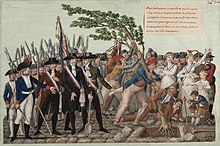Freedom tree


A freedom tree was one of the signs that also symbolized freedom in the French Revolution .
The name goes back to an elm tree in Boston . Two straw dolls were hung from this tree in August 1765 in protest against the Stamp Act . Under this tree the tax collectors later had to swear never to sell stamps. The elm was then baptized " Tree of Liberty " (Eng. "Tree of Freedom") and was the symbol of recognition of the " Sons of Freedom ". In 1775 it was felled by order of the authorities.
In the following years it became fashionable in European countries to plant or erect trees - mostly spruce and fir trees - as symbols of freedom and to decorate them with ribbons and flags. It is said that the Marquis de La Fayette brought this custom to France. The Jacobins , for example, set up the first “arbre de la liberté” in Paris in 1790 , crowned it with the liberty cap and danced around it while they sang revolutionary songs. This dance around the freedom tree quickly became one of the celebrations of the revolution. Usually a tree was set up, similar to a maypole , decorated with blue-white-red ribbons and danced around. Poplars were also popular because the French term “peuplier” implies the word “peuple” ( people ). As early as 1792, trees of freedom are said to have stood as symbols of victory in around 60,000 locations in the republic.
In Germany , too , trees of freedom were spontaneously set up, for example by the Jacobin clubs in the Rhine-Hessian towns and communities that belonged to the short-lived Mainz Republic , and allegedly also by students from Tübingen . However, as a commitment to the ideals of the revolution, the erection of trees of freedom was severely punished in the German principalities. Conversely, the erection of trees of freedom in the new départements of the left bank of the Rhine conquered by the French was partly officially ordered, as well as in Napoleonic vassal states such as the Kingdom of Westphalia . These were then solemn state acts in which the new rulers at least outwardly demanded a commitment to the new state.
After the custom had already gone out of fashion during the French rule in the Palatinate, trees of freedom were again erected in many places around the Hambach Festival in 1832 as a symbol of protest against the social and economic grievances. The ban was soon followed by the Bavarian authorities and the request to remove the symbols of protest. Trees of freedom were also planted again during the February Revolution in France in 1848 , but were removed by a government decree in 1850.
Individual evidence
- ↑ For historical representations, especially of the dance around the tree of freedom in picture journalism, cf. Martin Höppl: Prints of the French Revolution. Art history, cultural anthropology and collective psyche. In: Helikon. A Multidisciplinary Online Journal. 1, 2010, ISSN 2195-2868 , pp. 144-183, online (PDF; 6.9 MB) .
- ^ Willi Alter (Ed.): Pfalzatlas. Text volume 3rd Palatinate Society for the Advancement of Science, Speyer 1988.